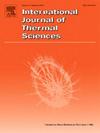新颖的合并和重新划分微通道散热器系统,以增强传热和降低流动阻力
IF 4.9
2区 工程技术
Q1 ENGINEERING, MECHANICAL
International Journal of Thermal Sciences
Pub Date : 2025-07-22
DOI:10.1016/j.ijthermalsci.2025.110160
引用次数: 0
摘要
可再生能源和大功率电子设备的集成需要高效紧凑的热交换器,以便在有限的空间内有效地散发产生的热量。微通道(MC)散热器结构表现出优异的传热性能。然而,它们的高流动阻力限制了它们在较大冷却表面的应用。本研究提出了一种通过沿冷却介质流动方向周期性合并和重新划分mc来降低流动阻力的方法。该设计增加了横截面积,减少了阻力,使边界层能够重新发展。这一过程弥补了合并mc引起的对流换热效率的降低。结果表明,当雷诺数在58 ~ 175之间时,热流密度(Q)可达308 kW/m2。在10 ~ 30 L/h的流速范围内,流动阻力与压降呈近似线性关系。此外,该研究还探讨了驱动传热增强的机制。采用优度因子对散热器的性能进行了评价。当雷诺数为58 ~ 175时,换热面积优良系数在1.14 ~ 1.12之间。调整MC的几何参数,如增加MC的高度,选择合适的分布长度和宽度,可以显著提高MC的换热性能,研究结果可以指导大型MC散热器的设计,以提高散热效率。本文章由计算机程序翻译,如有差异,请以英文原文为准。
Novel merging and redividing microchannel heat sink system for enhanced heat transfer and reduced flow resistance
The integration of renewable energy sources and high-power electronics requires efficient compact heat exchangers to effectively dissipate the heat generated in a limited space. Microchannel (MC) heat sink structures demonstrate exceptional heat transfer properties. However, their high flow resistance limits their application for larger cooling surfaces. This study proposes a method to reduce flow resistance by periodically merging and redividing MCs in the direction of the cooling medium flow. The design increases the cross-sectional area, reducing resistance and enabling the boundary layer to redevelop. This process compensates for the reduction in convection heat transfer efficiency caused by merging the MCs. The results reveal that for Reynolds numbers ranging between 58 and 175, the heat flux (Q) achieved can be up to 308 kW/m2. At water flow rates ranging from 10 to 30 L/h, the flow resistance exhibits an approximately linear relationship with the pressure drop. Additionally, the study examines the mechanisms driving heat transfer enhancement. A goodness factor was used to evaluate the performance of the heat sinks. It was observed that for Reynolds numbers between 58 and 175, the heat transfer area goodness factor falls between 1.14 and 1.12. Adjusting the geometric parameters, such as increasing the height of the MCs and selecting appropriate distributed lengths and widths, significantly enhances the heat transfer performance of the MC. The findings of this study may guide the design of large-scale MC heat sinks to improve heat dissipation efficiency.
求助全文
通过发布文献求助,成功后即可免费获取论文全文。
去求助
来源期刊

International Journal of Thermal Sciences
工程技术-工程:机械
CiteScore
8.10
自引率
11.10%
发文量
531
审稿时长
55 days
期刊介绍:
The International Journal of Thermal Sciences is a journal devoted to the publication of fundamental studies on the physics of transfer processes in general, with an emphasis on thermal aspects and also applied research on various processes, energy systems and the environment. Articles are published in English and French, and are subject to peer review.
The fundamental subjects considered within the scope of the journal are:
* Heat and relevant mass transfer at all scales (nano, micro and macro) and in all types of material (heterogeneous, composites, biological,...) and fluid flow
* Forced, natural or mixed convection in reactive or non-reactive media
* Single or multi–phase fluid flow with or without phase change
* Near–and far–field radiative heat transfer
* Combined modes of heat transfer in complex systems (for example, plasmas, biological, geological,...)
* Multiscale modelling
The applied research topics include:
* Heat exchangers, heat pipes, cooling processes
* Transport phenomena taking place in industrial processes (chemical, food and agricultural, metallurgical, space and aeronautical, automobile industries)
* Nano–and micro–technology for energy, space, biosystems and devices
* Heat transport analysis in advanced systems
* Impact of energy–related processes on environment, and emerging energy systems
The study of thermophysical properties of materials and fluids, thermal measurement techniques, inverse methods, and the developments of experimental methods are within the scope of the International Journal of Thermal Sciences which also covers the modelling, and numerical methods applied to thermal transfer.
 求助内容:
求助内容: 应助结果提醒方式:
应助结果提醒方式:


